Physical Address
304 North Cardinal St.
Dorchester Center, MA 02124
Physical Address
304 North Cardinal St.
Dorchester Center, MA 02124
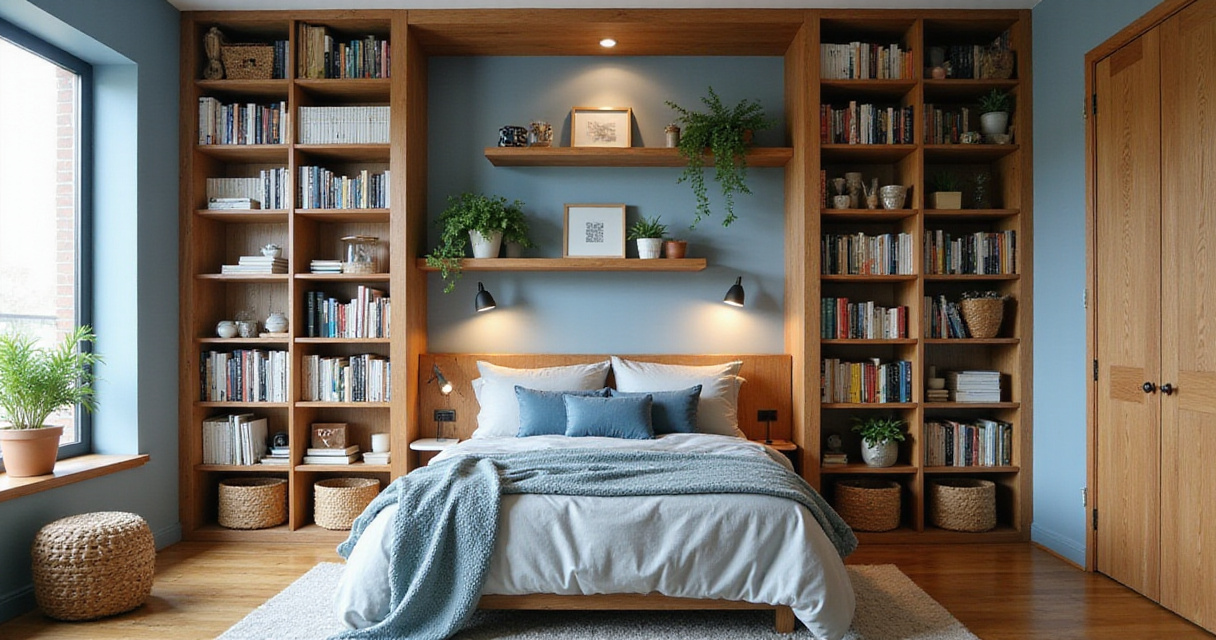
Transform your compact space with these 21 small bedroom ideas that maximize storage, create visual spaciousness, and bring spa-like tranquility to even the tightest quarters.
In the quest for peaceful living spaces, small bedrooms often present the biggest challenge. When square footage is limited, creating a sanctuary that feels both spacious and serene requires thoughtful design strategies. As someone who has designed wellness spaces for over a decade, I’ve discovered that the principles of spa design can transform even the tiniest bedroom into a rejuvenating retreat.
The secret to small bedroom success isn’t found in sacrificing style or function—it’s about embracing smart solutions that maximize every inch while creating a sense of calm. These 21 small bedroom ideas will help you create a space where you can truly unwind, recharge, and wake up feeling refreshed, no matter how limited your square footage may be.
In small bedrooms, your walls represent valuable real estate that’s often underutilized. By thinking vertically, you can dramatically increase storage capacity without sacrificing precious floor space. Wall-mounted shelving, hanging organizers, and tall cabinets draw the eye upward, creating the illusion of height while providing practical storage solutions for everything from books to beauty products.

Many homeowners hesitate to add vertical elements, fearing they’ll make the room feel crowded. However, thoughtfully placed wall storage actually has the opposite effect—it lifts visual weight off the floor, making the room feel more open and breathable. The key is choosing pieces with clean lines and leaving some negative space between items to maintain that essential sense of airiness.
The inspiration for this collection struck when I visited a Japanese ryokan, where vertical storage transformed tiny sleeping quarters into serene retreats. This approach doesn’t just save space—it elevates your entire room’s design while keeping essentials within reach.
The space beneath your bed represents some of the most valuable—and often wasted—real estate in small bedrooms. By intentionally elevating your sleeping surface, you can unlock a surprising amount of hidden storage. This strategy is particularly effective because it utilizes space that would otherwise gather dust, transforming it into functional storage without visually cluttering the room.
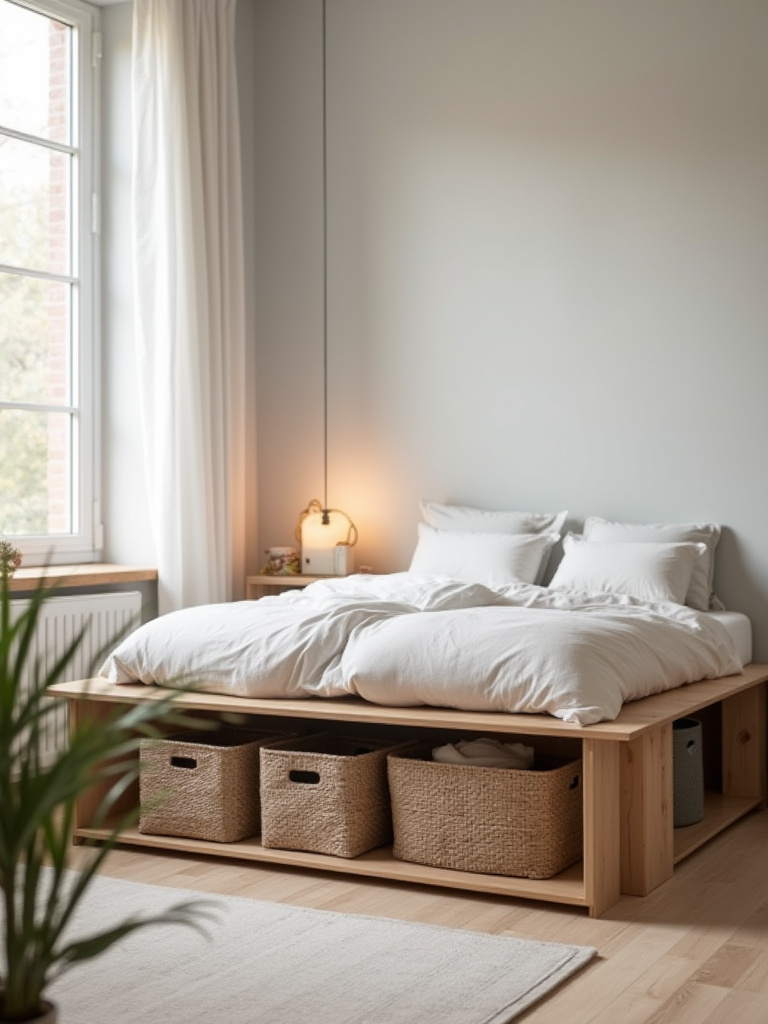
When selecting under-bed storage solutions, consider both accessibility and aesthetics. Rolling drawers offer easy access to frequently used items, while vacuum-sealed bags work wonderfully for seasonal clothing or extra bedding. For a more integrated look, platform beds with built-in drawers provide seamless storage that maintains the spa-like simplicity essential to a tranquil bedroom retreat.
“The most effective small bedroom designs treat every inch as precious—including the often-forgotten space beneath the bed.” — Nina Patel
What makes this design special is the way it maintains the clean, uncluttered look of a wellness space while significantly increasing your storage capacity. Next, let’s explore how to extend this vertical thinking to your walls with floating shelves.
Wall-mounted shelves bring an ethereal quality to small bedrooms that standard bookcases simply cannot match. These “floating” solutions create storage and display space without the visual weight of furniture legs or bulky structures. In wellness design, we often use floating elements to create a sense of lightness and tranquility—exactly what you want in a small bedroom retreat.
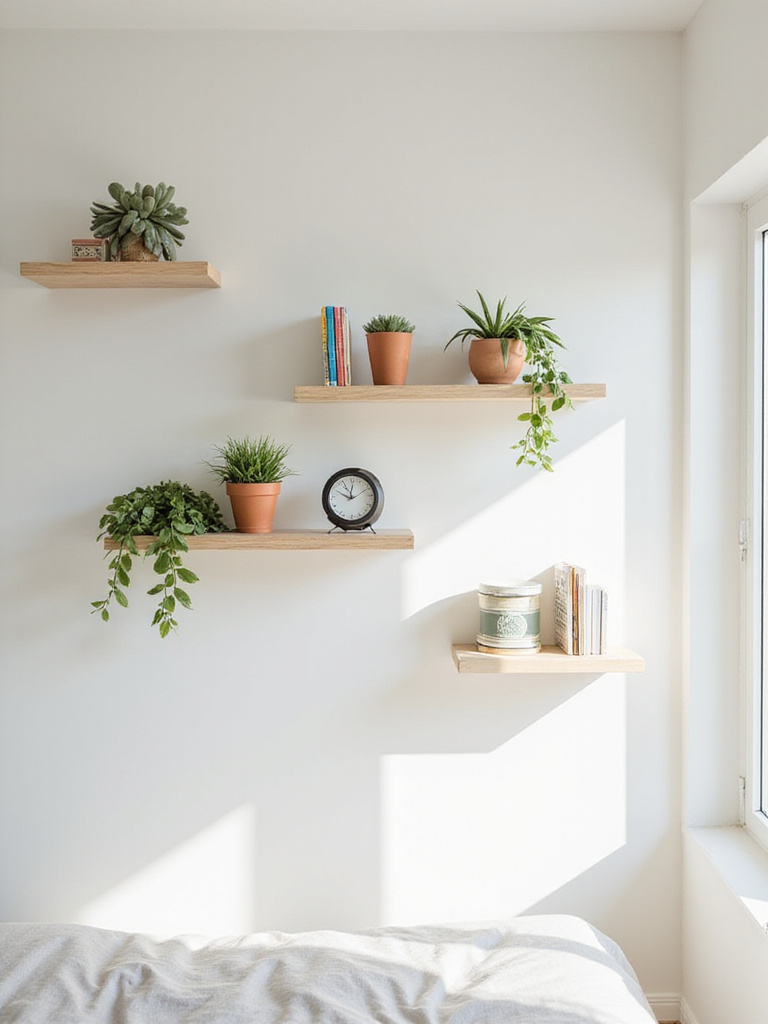
The beauty of floating shelves extends beyond mere functionality. They can be arranged in artistic configurations, becoming design features in their own right. Whether you opt for minimalist floating nightstands flanking your bed or a cascade of shelves creating an asymmetrical display wall, these installations keep your floor clear while adding architectural interest to your space.
The magic of this piece lies in its ability to transform not just how your room functions, but how it feels. With floor space freed up and essentials elegantly displayed, your small bedroom begins to embody that coveted spa-like serenity. Speaking of transformative furniture, let’s explore how your bed itself can disappear when not needed.
For truly limited spaces, few solutions are as transformative as a Murphy bed. These ingenious designs fold up against the wall when not in use, instantly converting your Sleeping Space into a functional living area. The dramatic space-saving potential makes Murphy beds particularly valuable in studio apartments or multi-purpose rooms where every square foot matters.
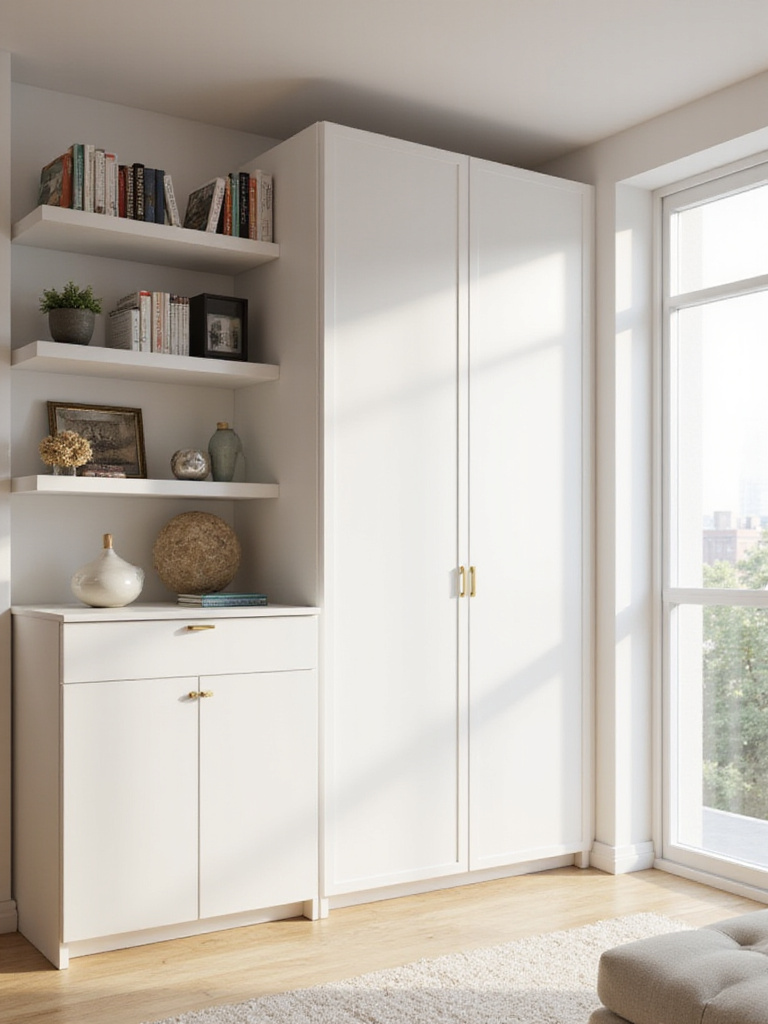
Modern Murphy beds have evolved far beyond their utilitarian origins. Today’s designs integrate seamlessly with custom cabinetry, often incorporating desks, shelving, or seating that remains accessible even when the bed is folded away. The transformation feels almost magical—like having two rooms in one—and creates a psychological separation between sleep and other activities that can enhance your wellness routine.
Unlike conventional options, this approach reduces your bedroom’s footprint during waking hours, creating breathing room that supports mental clarity. But what if you prefer to keep your bed accessible at all times while still maximizing floor space? That’s where our next small bedroom idea comes in.
The unexpected environmental benefit comes from loft beds’ ability to essentially double your usable space without increasing your home’s square footage. By elevating your sleeping area, you create an entirely new functional zone beneath—perfect for a home office, reading nook, or dressing area. This vertical zoning is a cornerstone of wellness space design, allowing distinct areas for different activities without visual clutter.

When implementing a loft bed in a small bedroom, ceiling height becomes your most important consideration. Ideally, you’ll want at least 30 inches of clearance between the mattress and ceiling to prevent a cramped feeling. The space below should be thoughtfully designed with proper lighting and furniture scaled to fit comfortably, creating a cohesive look rather than an afterthought.
“The most successful small bedroom designs don’t just save space—they create new possibilities for how you live in and interact with your environment.” — Nina Patel
The artisans behind these designs began with the understanding that physical elevation can create mental elevation too—the slight separation between sleeping and living spaces promotes better sleep hygiene and mental boundaries. For those who prefer a more traditional bed placement, our next strategy focuses on furniture proportions.
In small bedrooms, bulky furniture quickly becomes the enemy of serenity. Pieces with narrow profiles—think slim nightstands, low-profile dressers, and minimalist bed frames—preserve precious floor space while maintaining functionality. This approach is fundamental in spa design, where clean lines and breathing room create a sense of expansiveness even in compact spaces.
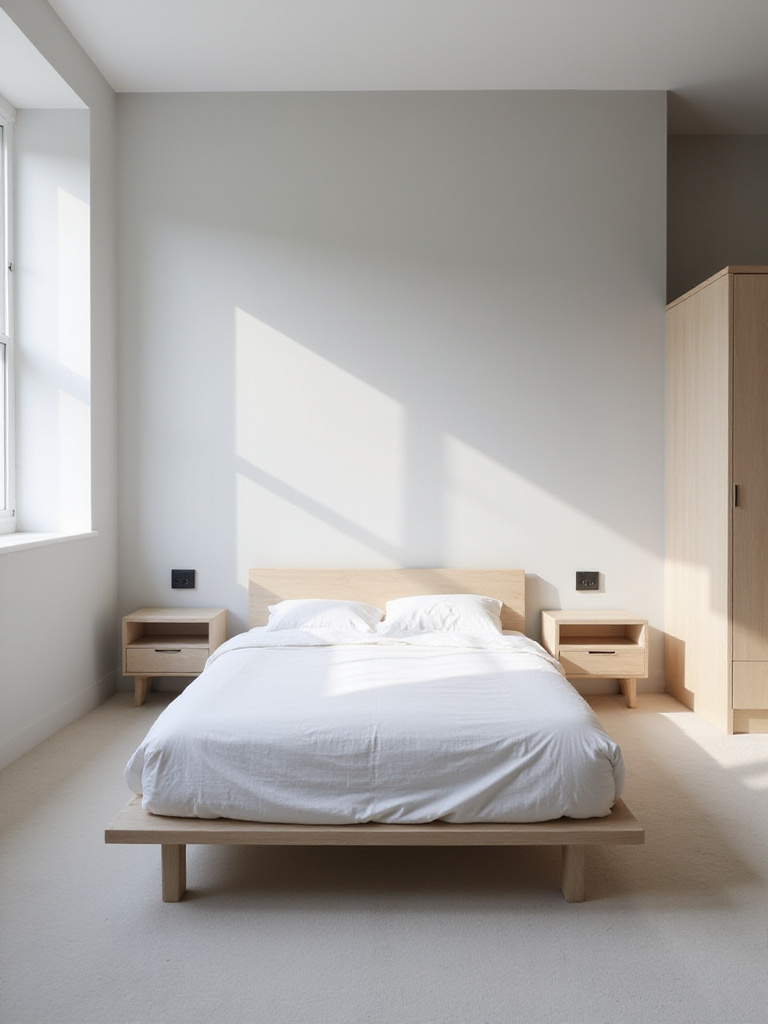
The impact of switching to slimmer furniture can be dramatic. A nightstand that’s just 4 inches narrower creates 8 additional inches of walkway space in a typical bedroom (accounting for both sides). Similarly, a bed frame without an oversized footboard or bulky side rails can make a room feel significantly more spacious without sacrificing comfort or style.
When clients ask us about balancing style with comfort, we often recommend this “slim down” approach as the first step toward a more tranquil small bedroom. The visual weight balances perfectly when furniture proportions match the scale of your space. Now, let’s explore how multi-functional pieces can further optimize your small bedroom.
The environmental story behind multi-functional furniture began with the recognition that consuming less—fewer pieces made with fewer materials—benefits both our spaces and our planet. In small bedroom design, pieces that serve multiple purposes eliminate the need for additional furniture, reducing visual clutter while maximizing functionality. A bench that offers seating and storage, a headboard with built-in lighting, or an ottoman that transforms into a desk exemplify this space-saving approach.
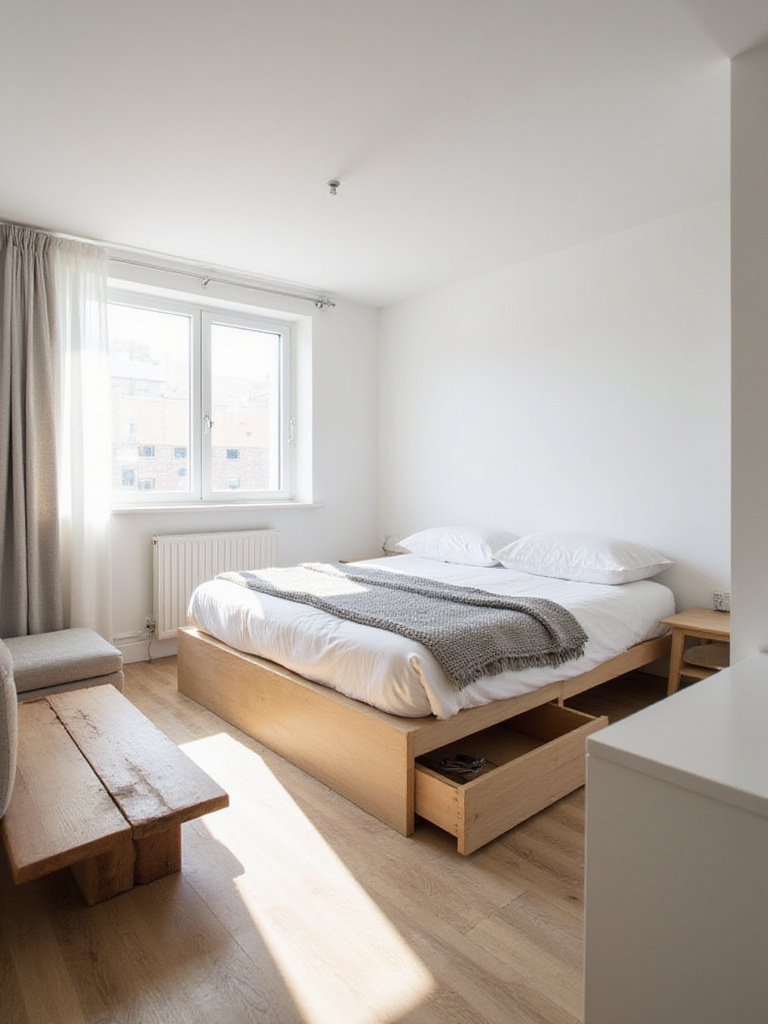
When selecting multi-functional pieces, prioritize quality construction and intuitive design. The best examples transition smoothly between functions without complicated mechanisms or awkward compromises. They should perform each role equally well, rather than being mediocre at multiple things. This thoughtful curation aligns perfectly with wellness design principles, where each element serves a clear purpose without unnecessary complications.
Beyond aesthetics, the ecological impact matters because multi-functional furniture typically has a longer useful life than single-purpose pieces, reducing waste and resource consumption. Now, let’s explore how mirrors can complement these space-saving strategies by creating visual expansion.
The craftsmanship reveals itself in details like properly placed mirrors that can visually double the size of a small bedroom. This optical illusion works by reflecting light, color, and space back into the room, tricking the eye into perceiving greater depth and dimension. In wellness design, we strategically position mirrors to amplify natural light and create a sense of expansiveness that supports mental wellbeing.
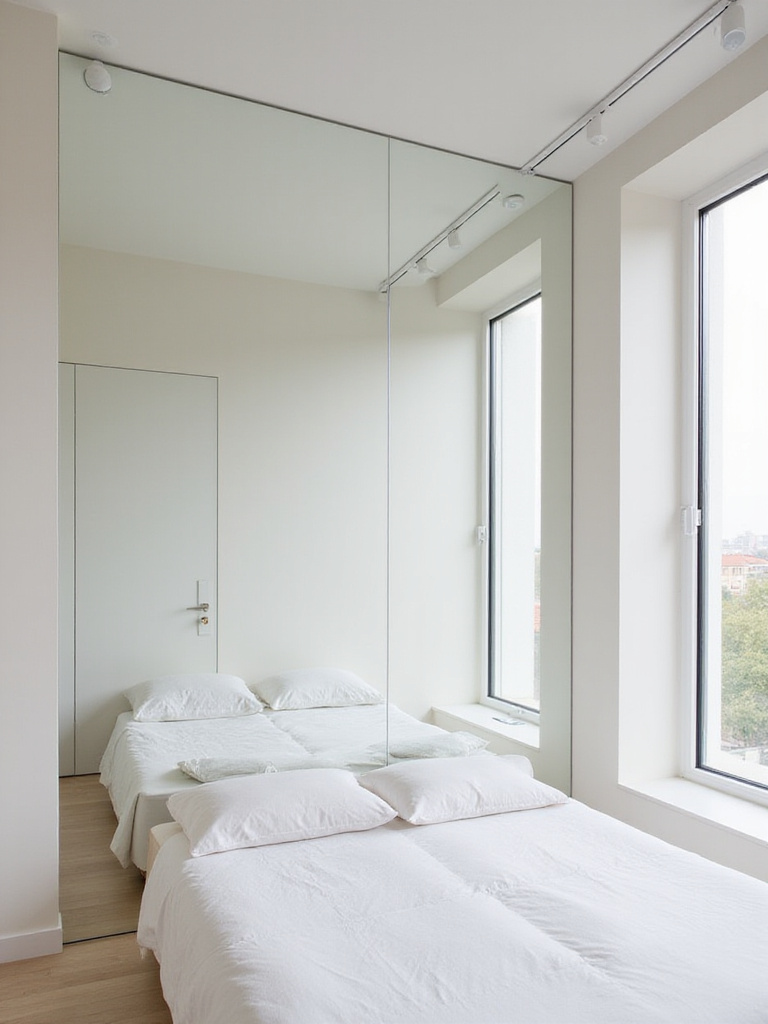
The most effective mirror placements respond to your specific room configuration. Positioning a large mirror opposite a window captures and multiplies natural light while reflecting outdoor views, blurring the boundaries between inside and outside. A full-length mirror on a closet door or wall not only serves practical dressing needs but also visually expands the room’s dimensions when properly positioned.
The interplay between the colors and reflections creates a dynamic visual experience that makes your small bedroom feel more expansive and luxurious. As you implement these mirror strategies, consider how your color palette can further enhance the feeling of spaciousness.
The color story emerging this year in small bedroom ideas emphasizes light, airy tones that expand visual space. Soft whites, pale blues, gentle greens, and subtle lavenders reflect light rather than absorb it, pushing walls outward visually and creating a sense of expansiveness. These spa-inspired hues also promote relaxation and tranquility—essential qualities for a restful bedroom environment.

When selecting paint colors for small bedrooms, consider both the quality of natural light and your personal color preferences. North-facing rooms benefit from warmer whites with yellow or peach undertones to counteract cooler light, while south-facing rooms can handle cooler whites and pastels. The finish matters too—an eggshell or satin finish reflects light better than flat paint, enhancing the space-expanding effect without creating harsh glare.
“Color isn’t just decorative in small spaces—it’s architectural. The right hue can visually push walls outward, creating breathing room where there physically is none.” — Nina Patel
The unexpected pairing that always works is combining these light wall colors with slightly deeper tones on trim or ceiling details, creating subtle dimension without overwhelming the space. While color sets the stage for your small bedroom retreat, thoughtful lighting completes the transformation.
For those worried about maintenance, lighting is one of the most powerful yet low-maintenance tools for enhancing small bedrooms. Layered lighting—combining ambient, task, and accent sources—creates depth, dimension, and flexibility that a single overhead fixture simply cannot provide. This approach mirrors high-end spa design, where lighting transforms spaces from functional to atmospheric with the touch of a dimmer.

Effective lighting layers in small bedrooms might include soft ambient light from a semi-flush ceiling fixture, targeted task lighting from adjustable wall sconces flanking the bed (eliminating the need for table lamps and nightstands), and accent lighting highlighting artwork or architectural features. Dimmers on each circuit allow you to adjust the mood and brightness throughout the day, supporting your circadian rhythm and various activities.
The emotional response this evokes begins with a sense of control over your environment—a key aspect of wellness design. With lighting that adapts to your needs throughout the day, your small bedroom feels more responsive and customized. Now, let’s address perhaps the most fundamental aspect of creating space: removing what you don’t need.
The designer’s secret here is understanding that physical clutter creates mental clutter—a concept central to wellness space design. In small bedrooms, this connection is even more pronounced, as limited space amplifies the visual impact of every object. Decluttering isn’t just about creating physical space; it’s about creating mental space that allows for true relaxation and rejuvenation.
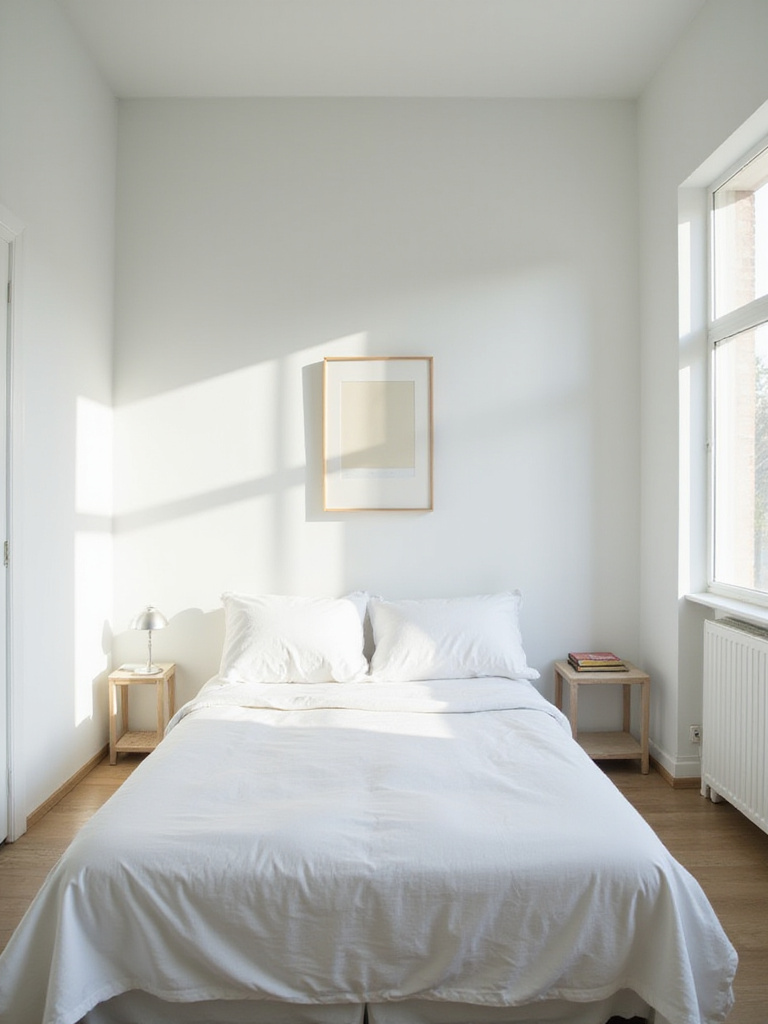
Approaching decluttering with intentionality rather than deprivation changes the experience entirely. Instead of focusing on what to eliminate, consider what to preserve—those items that serve a purpose or bring genuine joy. This positive framing aligns with wellness principles and makes the process less overwhelming. Start with visible surfaces, then move to drawers and closets, creating systems that make maintaining order simple.
The chameleon-like piece adapts to various styles by existing in a clutter-free environment where its design can be fully appreciated. With a streamlined collection of belongings, you’re ready to explore how furniture arrangement can maximize your newly decluttered space.
Many homeowners wonder how to maintain bedside convenience without sacrificing floor space. Wall-mounted alternatives to traditional nightstands offer an elegant solution that supports both functional needs and spatial openness. These floating options—whether simple shelves, small cabinets, or purpose-built wall-mounted nightstands—keep essentials within reach while eliminating the footprint of conventional bedside tables.
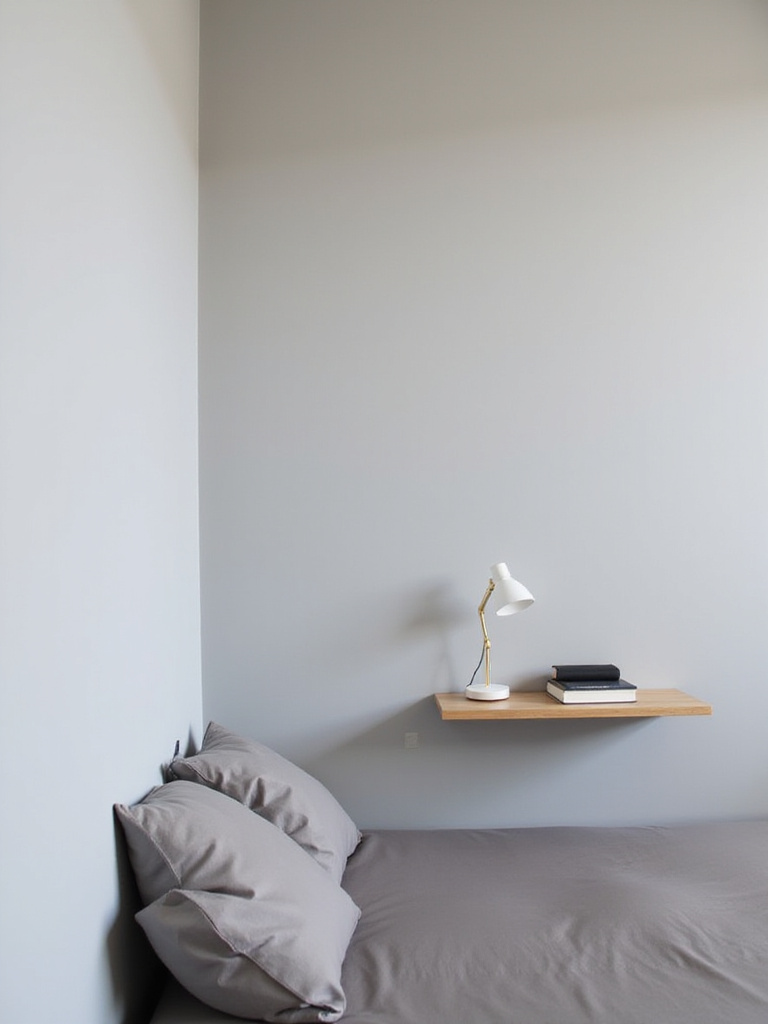
The benefits extend beyond mere space-saving. Without nightstand legs creating visual boundaries, the floor flows uninterrupted, creating a sense of openness that’s particularly valuable in small bedrooms. This continuous flooring visually expands the room while making cleaning easier—a practical consideration that enhances the maintenance of your serene retreat.
The styling mistake most people make is assuming they need matching nightstands on both sides of the bed. In small bedrooms, asymmetrical solutions often work better, responding to the specific needs of each side. Looking beyond the bed area, let’s explore how corners—often wasted space—can become functional assets.
The third-generation workshop where corner solutions come to life understands that these often-neglected spaces represent valuable square footage in small bedrooms. Corner shelves and desks fit naturally into these awkward angles, transforming dead space into functional storage or work areas without protruding too far into the room. This geometric efficiency is a hallmark of thoughtful small space design.
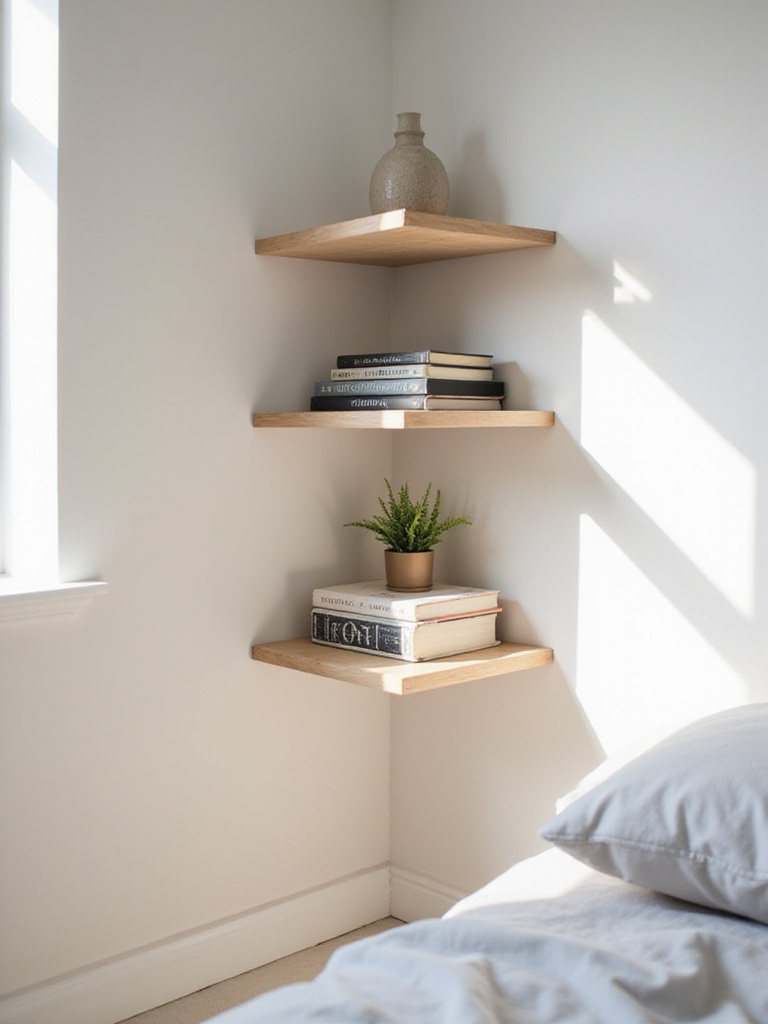
When implementing corner solutions, consider both height and depth carefully. Graduated corner shelves that start deeper at the bottom and become shallower as they rise create visual interest while accommodating different-sized items. For corner desks, look for designs with rounded outer edges rather than sharp corners to improve flow around the piece and reduce painful hip bumps in tight quarters.
The versatility reveals itself when you pair these corner solutions with other small bedroom ideas, creating a comprehensive approach to space optimization. Now, let’s consider how the doors in your small bedroom can contribute to or detract from your space-saving efforts.
The revival of this classic form comes with a twist as sliding doors make a stylish comeback in small bedroom design. By eliminating the swing arc required by traditional hinged doors, sliding alternatives—whether pocket doors that disappear into the wall or surface-mounted sliding doors—free up valuable floor space and expand furniture placement options. This simple switch can reclaim up to 10 square feet of usable space per door.
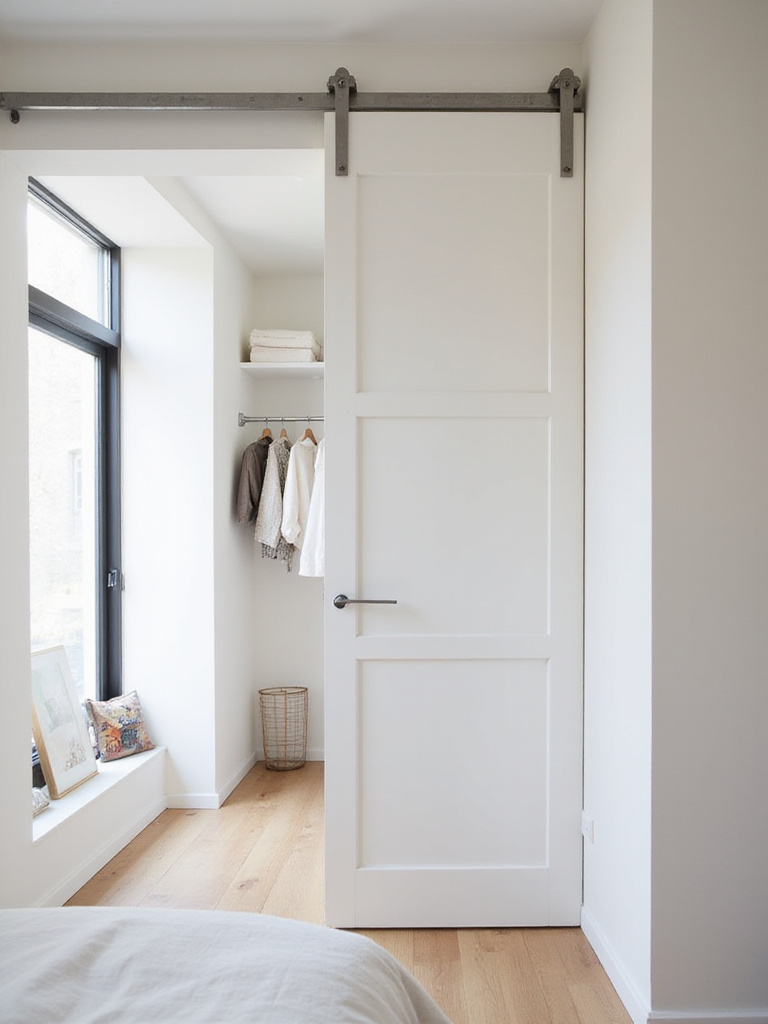
Beyond the practical space-saving benefits, sliding doors offer aesthetic advantages that enhance small bedroom designs. They can become architectural features that add character through interesting hardware, material choices, or integrated mirrors. The linear movement of these doors reinforces the clean, uncluttered lines that contribute to a serene spa-like atmosphere.
“In wellness space design, we consider not just how elements look, but how they move. Sliding doors create a smoother, more graceful flow that contributes to the overall sense of calm.” — Nina Patel
As morning light filters through, the texture creates beautiful patterns across these sliding surfaces, adding dynamic visual interest throughout the day. With doors that conserve space rather than consume it, let’s turn our attention to another opportunity for integration: the headboard.
The craftsmanship in this collection tells a story of ingenious space utilization through multi-functional headboards. These clever designs transform what’s typically just a decorative element into valuable storage real estate, incorporating shelves, cabinets, or cubbies directly into the structure behind your head. For small bedrooms, this integration eliminates the need for separate nightstands or even bookcases, streamlining the room’s footprint.
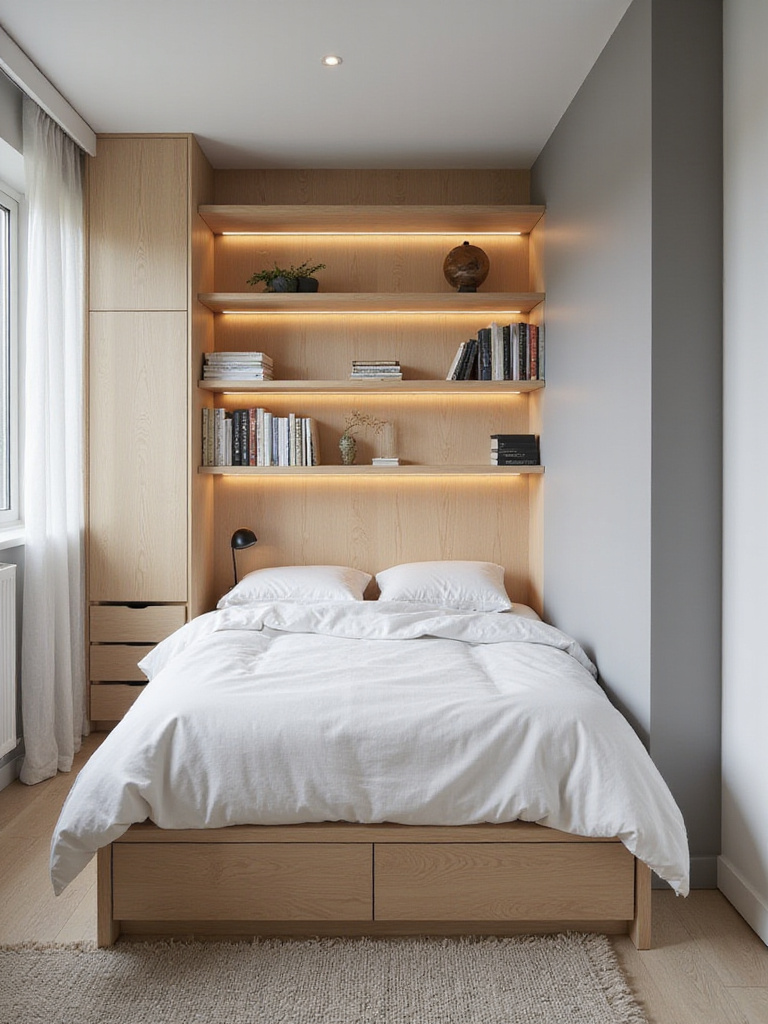
When selecting a storage headboard, consider both your storage needs and the visual impact. Some designs feature open shelving for displaying books and decorative items, while others offer closed storage that maintains a cleaner look. The width typically extends beyond the bed itself, creating a built-in look that anchors the room while providing ample storage space. Materials and finishes should complement your overall design scheme while being durable enough for daily use.
If you’ve struggled with similar rooms before, you’ll appreciate how this single element can replace multiple pieces of furniture while maintaining a cohesive, uncluttered aesthetic. Continuing our exploration of hidden storage opportunities, let’s look at how your bedroom door itself can become a storage asset.
The unexpected benefit comes from utilizing the often-forgotten vertical real estate on the back of your bedroom door. This surface—typically left bare—can support a surprising amount of storage without consuming any floor space or impacting the room’s visual openness. From over-the-door shoe organizers (which can store far more than just shoes) to custom-fitted racks and hooks, this strategy turns dead space into functional storage.
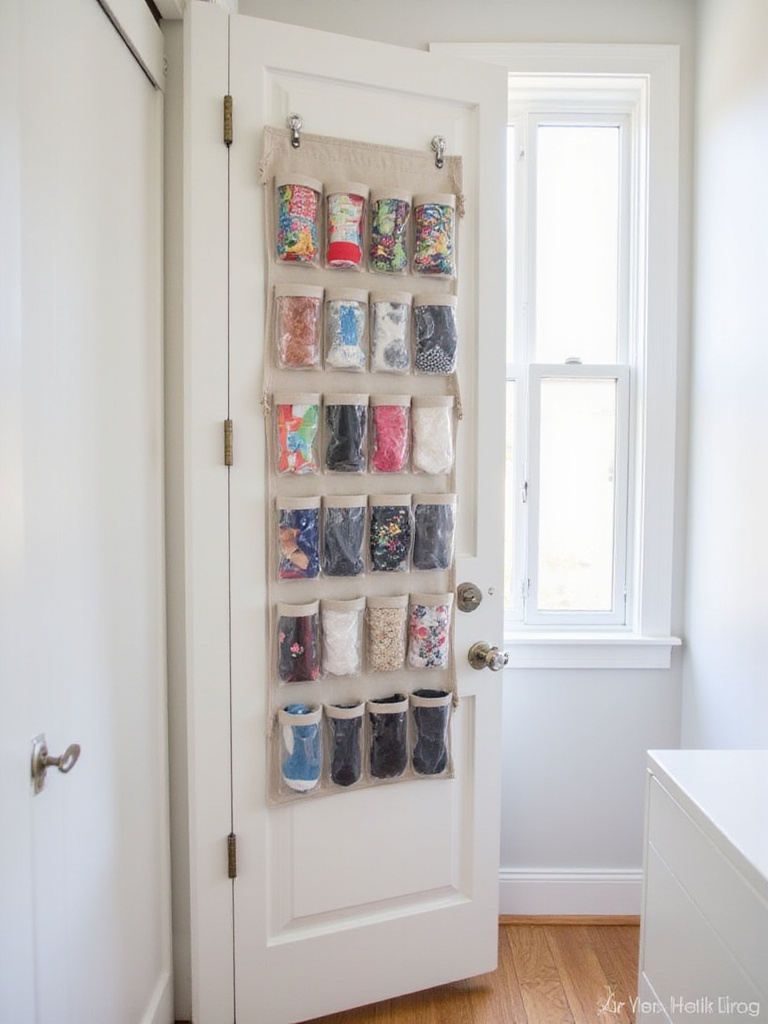
The beauty of door-back storage lies in its versatility and invisibility. When the door is closed, these organizers disappear from view, maintaining the clean aesthetic essential to a spa-like bedroom retreat. When open, they provide easy access to frequently used items without creating visual clutter on other surfaces. This hidden-yet-accessible approach aligns perfectly with wellness design principles that emphasize order without sacrificing convenience.
The composition comes together when you utilize every available surface, including those that are typically overlooked. With these practical storage solutions in place, we can turn our attention to the overall aesthetic approach that will unify your small bedroom design.
The artisan collective that creates these pieces understands that in small bedroom ideas, restraint often yields the most powerful results. Minimalism—characterized by clean lines, uncluttered surfaces, and a “less is more” philosophy—creates visual calm that makes spaces feel larger and more peaceful. This approach is particularly effective in small bedrooms, where every item competes for limited visual and physical space.

Embracing minimalism doesn’t mean creating a stark or impersonal environment. Rather, it involves carefully curating fewer, more meaningful items that serve both functional and aesthetic purposes. Choose quality over quantity, selecting pieces with clean lines and dual functionality where possible. Limit decorative objects to a thoughtful few that hold genuine meaning or beauty, allowing each to be appreciated rather than lost in visual noise.
The ambiance evolves throughout the day as natural light interacts with these thoughtfully selected elements, creating a dynamic yet serene environment. With a minimalist foundation established, let’s explore how furniture arrangement can further enhance your small bedroom’s functionality and flow.
The subtle fragrance fills the room while thoughtfully arranged furniture creates an intuitive flow through your small bedroom. Strategic placement isn’t just about fitting pieces into available space—it’s about creating pathways that feel natural and unobstructed, allowing both physical and visual movement throughout the room. This intentional arrangement is a cornerstone of wellness design, reducing stress by eliminating awkward navigation and creating a sense of order.
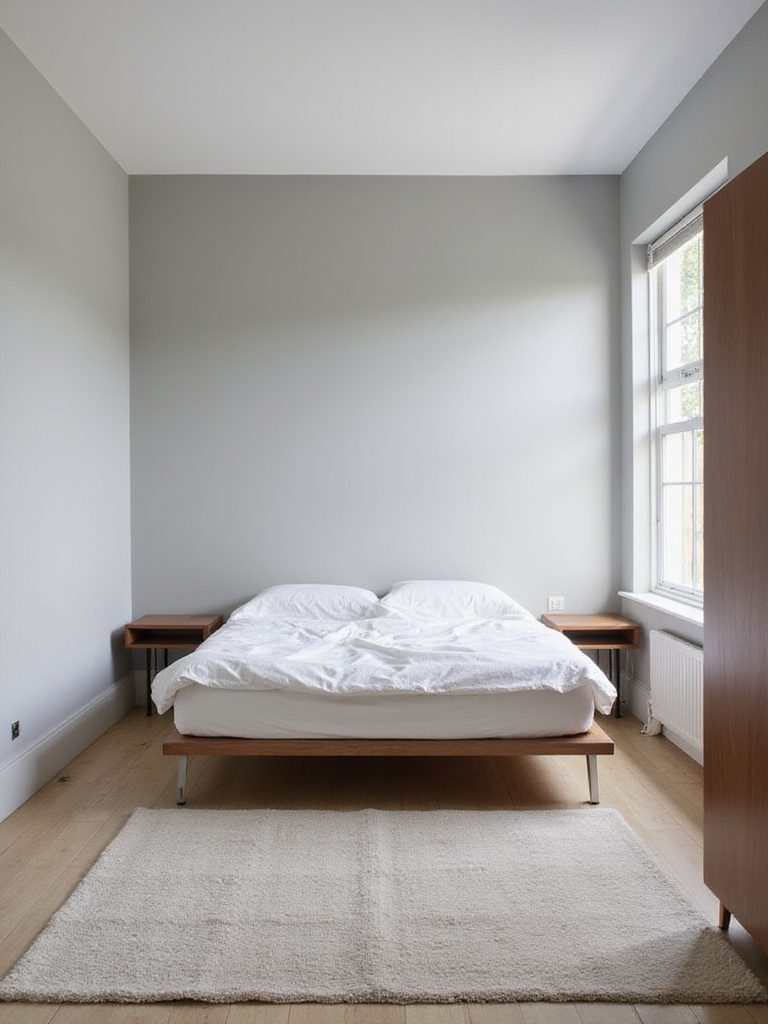
When arranging furniture in small bedrooms, start by identifying the room’s natural focal point—often the bed—and position it to maximize both functionality and aesthetic appeal. Consider traffic patterns, ensuring clear pathways to the closet, door, and other essential areas. Rather than pushing all furniture against walls (a common small-space mistake), try floating some pieces to create more interesting arrangements and defined zones within the room.
“The most successful small bedrooms aren’t necessarily the largest—they’re the ones where furniture placement creates an effortless dance between function and movement.” — Nina Patel
While designed for the living room, we’ve seen creative uses in bedrooms where strategic furniture placement transforms cramped quarters into flowing, functional retreats. For those ready to take their small bedroom design to the next level, custom storage solutions offer the ultimate in space optimization.
After months of sourcing and curation, many homeowners discover that custom built-ins offer unparalleled efficiency in small bedrooms. Unlike freestanding furniture that often leaves awkward gaps or doesn’t quite fit the dimensions of your space, built-ins can be designed to utilize every inch—including sloped ceilings, odd corners, or spaces around windows and doors. This tailored approach eliminates wasted space while creating a cohesive, integrated look.

The investment in custom storage pays dividends in both functionality and aesthetics. Built-ins can be designed to address your specific storage needs—from hanging space to shoe storage to display areas for treasured items—all while maintaining a clean, uncluttered appearance. They can incorporate lighting, mirrors, and even fold-down desks or vanities, transforming a single wall into a complete storage system that eliminates the need for multiple furniture pieces.
The traditional methods used result in storage solutions that feel like architectural elements rather than furniture additions, creating a more spacious feel in small bedrooms. As we continue optimizing vertical space, let’s explore how to draw the eye upward to enhance the perception of height.
The discovery of this technique happened when designers observed how vertical elements naturally draw the gaze upward, creating a perception of greater height and spaciousness in small bedrooms. By incorporating tall, slim furniture pieces, floor-to-ceiling curtains, or vertical decorative elements, you create visual pathways that expand the room’s perceived dimensions. This vertical emphasis is particularly valuable in spaces with low ceilings or limited square footage.

Implementing this strategy effectively requires balance and restraint. Select a few key vertical elements rather than filling the room with tall pieces that could feel overwhelming. A single floor-to-ceiling bookcase, for instance, creates more impact than multiple medium-height storage units. Similarly, hanging curtains from ceiling to floor (even if windows are shorter) creates an unbroken vertical line that heightens the entire space.
The visual weight balances perfectly when these vertical elements are complemented by lower, horizontal pieces that ground the space. With this vertical strategy in mind, let’s explore one specific furniture choice that exemplifies this approach—the vertical dresser.
Look closely and you’ll notice the subtle texture of space-saving that vertical dressers bring to small bedrooms. Unlike traditional wide dressers that consume valuable floor area, tallboys or chest-on-chests extend upward rather than outward, providing ample storage while maintaining a minimal footprint. This vertical orientation aligns perfectly with our strategy of drawing the eye upward to create a sense of greater space.
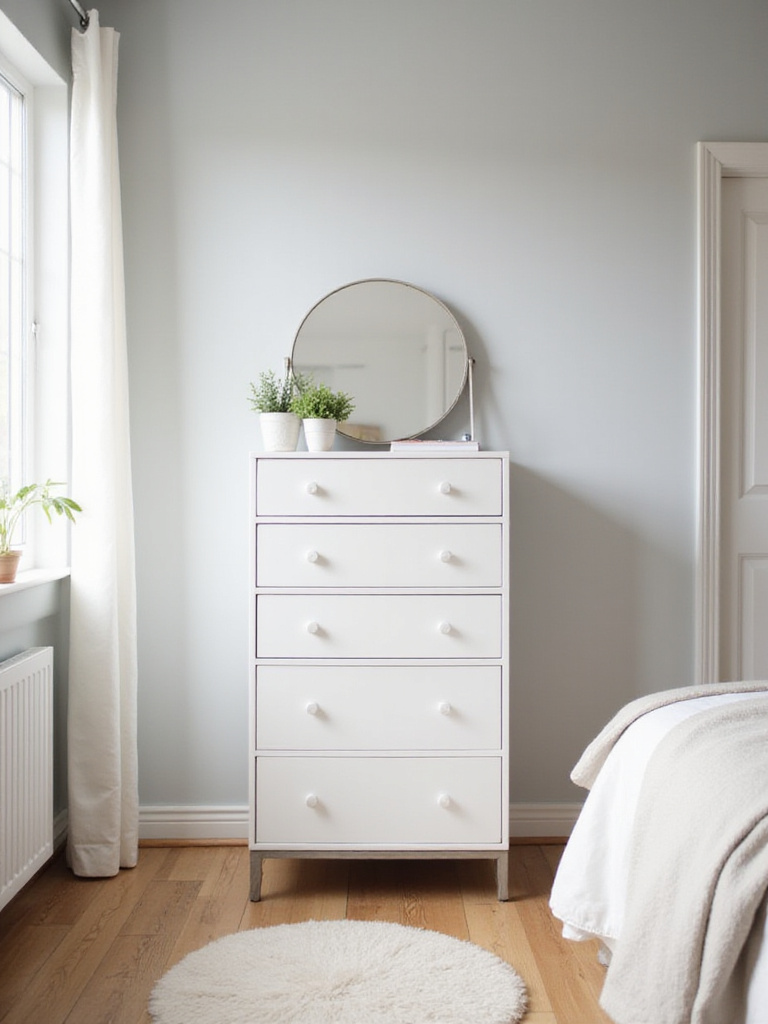
When selecting a vertical dresser, consider both proportions and stability. The ideal piece should be tall enough to provide significant storage without towering precariously or feeling out of scale with other furnishings. Ensure the drawers are deep enough to be functional while keeping the overall depth of the piece minimal. For safety, always anchor tall furniture to the wall, especially in earthquake-prone areas or homes with children or pets.
The sustainable journey of this material involves maximizing functionality while minimizing the resources used—both in terms of materials and the space consumed in your home. This approach epitomizes smart small bedroom design, where every element works efficiently without overwhelming the room.
Creating a serene, spa-like retreat in a small bedroom isn’t about grand gestures—it’s about thoughtful details and strategic decisions that maximize both physical space and visual openness. By implementing even a few of these 21 small bedroom ideas, you can transform your compact space into a sanctuary that supports rest, rejuvenation, and wellness.
Remember that in small bedroom design, less truly is more. Each item should earn its place through both functionality and beauty. Embrace vertical thinking, incorporate multi-functional pieces, and use visual tricks like mirrors and light colors to expand perceived space. Most importantly, create a room that reflects your personal needs and aesthetic preferences—a true retreat that welcomes you at the end of each day.
The journey to your ideal small bedroom may involve some trial and error, but the reward is a personalized sanctuary that feels spacious, organized, and deeply restorative. By applying these wellness-inspired small bedroom ideas, you’re not just decorating a room—you’re creating an environment that nurtures your wellbeing with every design choice.